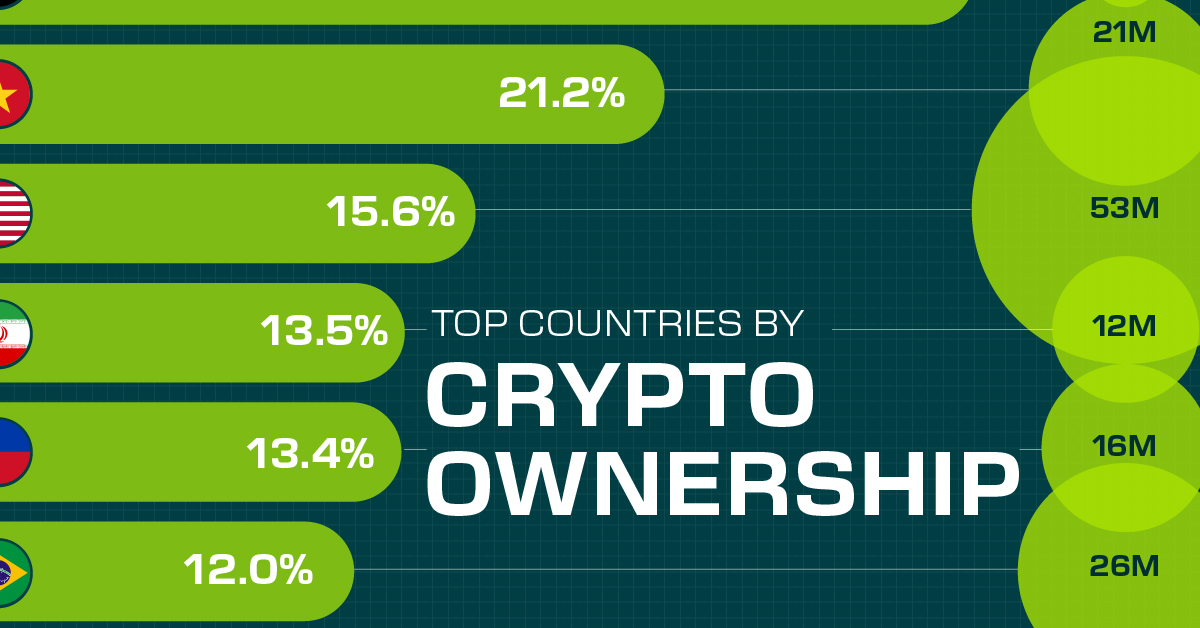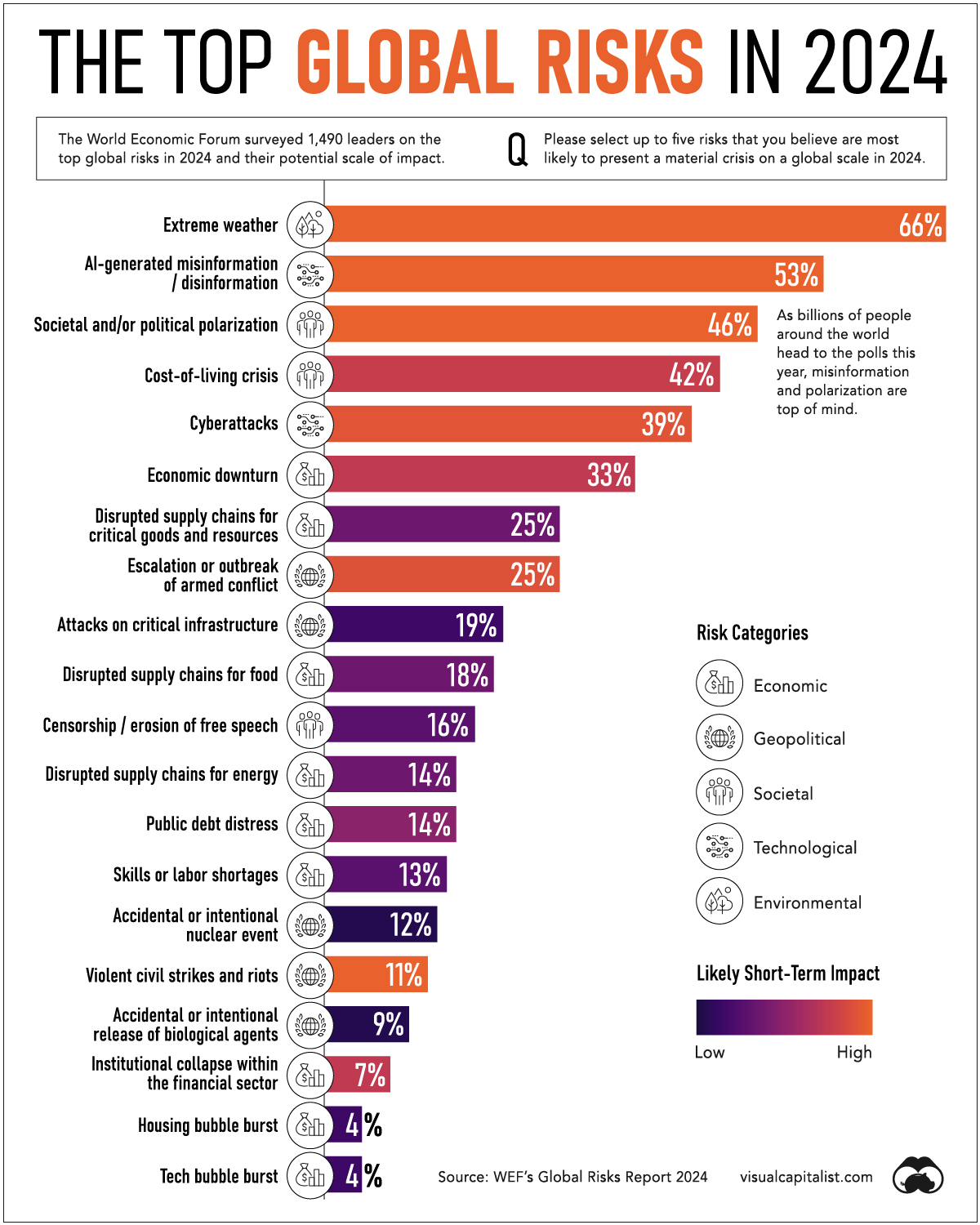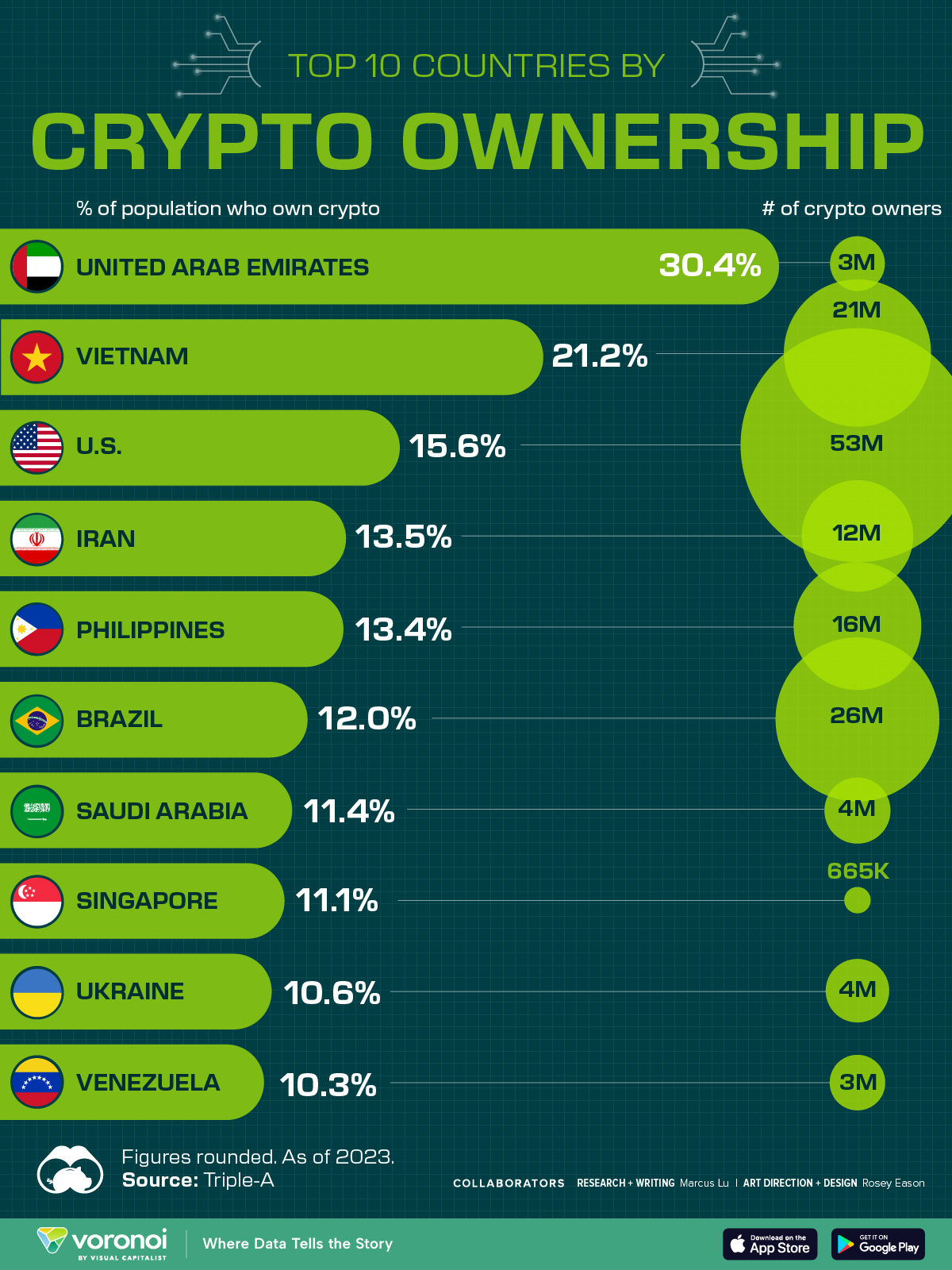Technology
Visualizing the Top Global Risks in 2024
![]() See this visualization first on the Voronoi app.
See this visualization first on the Voronoi app.
Visualizing the Top Global Risks in 2024
This was originally posted on our Voronoi app. Download the app for free on iOS or Android and discover incredible data-driven charts from a variety of trusted sources.
What is the global risk landscape in 2024?
Record global temperatures are leading to increasingly harmful impacts, a cost-of living crisis is making everyday life harder for people around the world, and escalating tensions in the Middle East have the potential to widen into a broader regional conflict.
Meanwhile, in 2024 it’s expected to be the world’s biggest election year ever with 4 billion people casting a vote across 60 countries. Will threats such as misinformation and polarization loom large as people head to the polls?
This visualization shows the biggest risks for 2024, based on the World Economic Forum’s annual survey of leaders around the globe.
Global Risk Profile in 2024
Here are the top 20 risks to the global economy, based on a survey of 1,490 leaders.
Leaders were asked to choose up to five risks that are likely to present a material crisis on a global scale in 2024:
| 2024 Ranking | Risk | Share of Respondents | Category |
|---|---|---|---|
| 1 | Extreme weather | 66% | Environmental |
| 2 | Misinformation and disinformation | 53% | Technological |
| 3 | Societal polarization | 46% | Societal |
| 4 | Cost-of-living crisis | 42% | Societal |
| 5 | Cyberattacks | 39% | Technological |
| 6 | Economic downturn | 33% | Economic |
| 7 | Disrupted supply chains for critical goods and resources | 25% | Economic |
| 8 | Escalation or outbreak of interstate armed conflict(s) | 25% | Geopolitical |
| 9 | Attacks on critical infrastructure | 19% | Geopolitical |
| 10 | Disrupted supply chains for food | 18% | Economic |
| 11 | Censorship and erosion of free speech | 16% | Societal |
| 12 | Disrupted supply chains for energy | 14% | Economic |
| 13 | Public debt distress | 14% | Economic |
| 14 | Skills or labor shortage | 13% | Economic |
| 15 | Accidental or intentional nuclear event | 12% | Geopolitical |
| 16 | Violent civil strikes and riots | 11% | Geopolitical |
| 17 | Accidental or intentional release of biological agents | 9% | Geopolitical |
| 18 | Institutional collapse within the financial sector | 7% | Economic |
| 19 | Housing bubble burst | 4% | Economic |
| 20 | Tech bubble burst | 4% | Economic |
Extreme weather poses the biggest risk according to leaders surveyed. It also ranks second overall in terms of severity over the next two years.
Global economies are widely unprepared for the consequences of acute weather, from shocks to food systems to large-scale infrastructure damage. In fact, some research shows that potentially irreversible changes to the planet could be reached by the 2030s if temperatures continue to rise.
Misinformation and disinformation is the second-biggest risk, which could diminish trust and deepen political divides. It also has the potential to undermine global elections, which are slated across the U.S., Russia, India, Mexico, and dozens of other countries.
The threat of misinformation is especially clear given advancements in AI-generated content. It ranks first overall in terms of risk severity across the list.
Interlinked with misinformation is the risk of societal polarization. In the post-pandemic era, political divides have worsened, and these have been exacerbated by economic hardship and a lack of economic opportunity.
Additionally, the conflict in the Middle East is severely impacting the livelihood of millions of people, and the recent attack in Lebanon raises questions about the outbreak of a wider war. The escalation of interstate armed conflicts ranks as the eighth-highest risk for the global economy in 2024, and the fifth-most severe.
Future Global Risks
How will global risks transform over the next decade?
By 2034, leaders surveyed believe that environmental risks will be most concerning, making up five of the top 10 risks, by severity:
| 2034 Ranking | Risk | Category |
|---|---|---|
| 1 | Extreme weather events | Environmental |
| 2 | Critical change to Earth systems | Environmental |
| 3 | Biodiversity loss and ecosystem collapse | Environmental |
| 4 | Natural resource shortages | Environmental |
| 5 | Misinformation and disinformation | Technological |
| 6 | Adverse outcomes of AI technologies | Technological |
| 7 | Involuntary migration | Societal |
| 8 | Cyber insecurity | Technological |
| 9 | Societal polarization | Societal |
| 10 | Pollution | Environmental |
We can see that technological risks of misinformation and the adverse outcomes of AI technologies also remain fairly dominant.
AI has the potential to be highly destabilizing to society, presenting some existential risks due to its role as a “force multiplier”, which means that it can increase the effect of a country’s military systems, data analytics, and other capabilities.
From a broader perspective, key structural forces are influencing global risks looking ahead. They include technological acceleration, climate change, shifts in geopolitical power, and a widening demographic divide.
Where does this data come from?
Source: The World Economic Forum’s Global Risks Report 2024.
Data note: The chart in this article is based on the Global Risks Perception Survey 2023-2024. A list of global risks and their definitions is shown in Table A.1 of the PDF. The report also includes detailed information on sample sizes and demographics of respondents, found on pg. 101.
Technology
Countries With the Highest Rates of Crypto Ownership
While the U.S. is a major market for cryptocurrencies, two countries surpass it in terms of their rates of crypto ownership.

Countries With the Highest Rates of Crypto Ownership
This was originally posted on our Voronoi app. Download the app for free on iOS or Android and discover incredible data-driven charts from a variety of trusted sources.
This graphic ranks the top 10 countries by their rate of cryptocurrency ownership, which is the percentage of the population that owns crypto. These figures come from crypto payment gateway, Triple-A, and are as of 2023.
Data and Highlights
The table below lists the rates of crypto ownership in the top 10 countries, as well as the number of people this amounts to.
| Country | % of Population Who Own Crypto | # of Crypto Owners |
|---|---|---|
| 🇦🇪 United Arab Emirates | 30.4 | 3M |
| 🇻🇳 Vietnam | 21.2 | 21M |
| 🇺🇸 U.S. | 15.6 | 53M |
| 🇮🇷 Iran | 13.5 | 12M |
| 🇵🇭 Philippines | 13.4 | 16M |
| 🇧🇷 Brazil | 12 | 26M |
| 🇸🇦 Saudi Arabia | 11.4 | 4M |
| 🇸🇬 Singapore | 11.1 | 665K |
| 🇺🇦 Ukraine | 10.6 | 4M |
| 🇻🇪 Venezuela | 10.3 | 3M |
Note that if we were to rank countries based on their actual number of crypto owners, India would rank first at 93 million people, China would rank second at 59 million people, and the U.S. would rank third at 52 million people.
The UAE Takes the Top Spot
The United Arab Emirates (UAE) boasts the highest rates of crypto ownership globally. The country’s government is considered to be very crypto friendly, as described in Henley & Partners’ Crypto Wealth Report 2023:
In the UAE, the Financial Services Regulatory Authority (FSRA-ADGM) was the first to provide rules and regulations regarding cryptocurrency purchasing and selling. The Emirates are generally very open to new technologies and have proposed zero taxes for crypto owners and businesses.
Vietnam leads Southeast Asia
According to the Crypto Council for Innovation, cryptocurrency holdings in Vietnam are also untaxed, making them an attractive asset.
Another reason for Vietnam’s high rates of ownership could be its large unbanked population (people without access to financial services). Cryptocurrencies may provide an alternative means of accessing these services without relying on traditional banks.
Learn More About Crypto From Visual Capitalist
If you enjoyed this post, be sure to check out The World’s Largest Corporate Holders of Bitcoin, which ranks the top 12 publicly traded companies by their Bitcoin holdings.
-

 Markets5 days ago
Markets5 days agoVisualizing Global Inflation Forecasts (2024-2026)
-

 Green2 weeks ago
Green2 weeks agoThe Carbon Footprint of Major Travel Methods
-

 United States2 weeks ago
United States2 weeks agoVisualizing the Most Common Pets in the U.S.
-

 Culture2 weeks ago
Culture2 weeks agoThe World’s Top Media Franchises by All-Time Revenue
-

 voronoi1 week ago
voronoi1 week agoBest Visualizations of April on the Voronoi App
-

 Wealth1 week ago
Wealth1 week agoCharted: Which Country Has the Most Billionaires in 2024?
-

 Business1 week ago
Business1 week agoThe Top Private Equity Firms by Country
-

 Markets1 week ago
Markets1 week agoThe Best U.S. Companies to Work for According to LinkedIn











